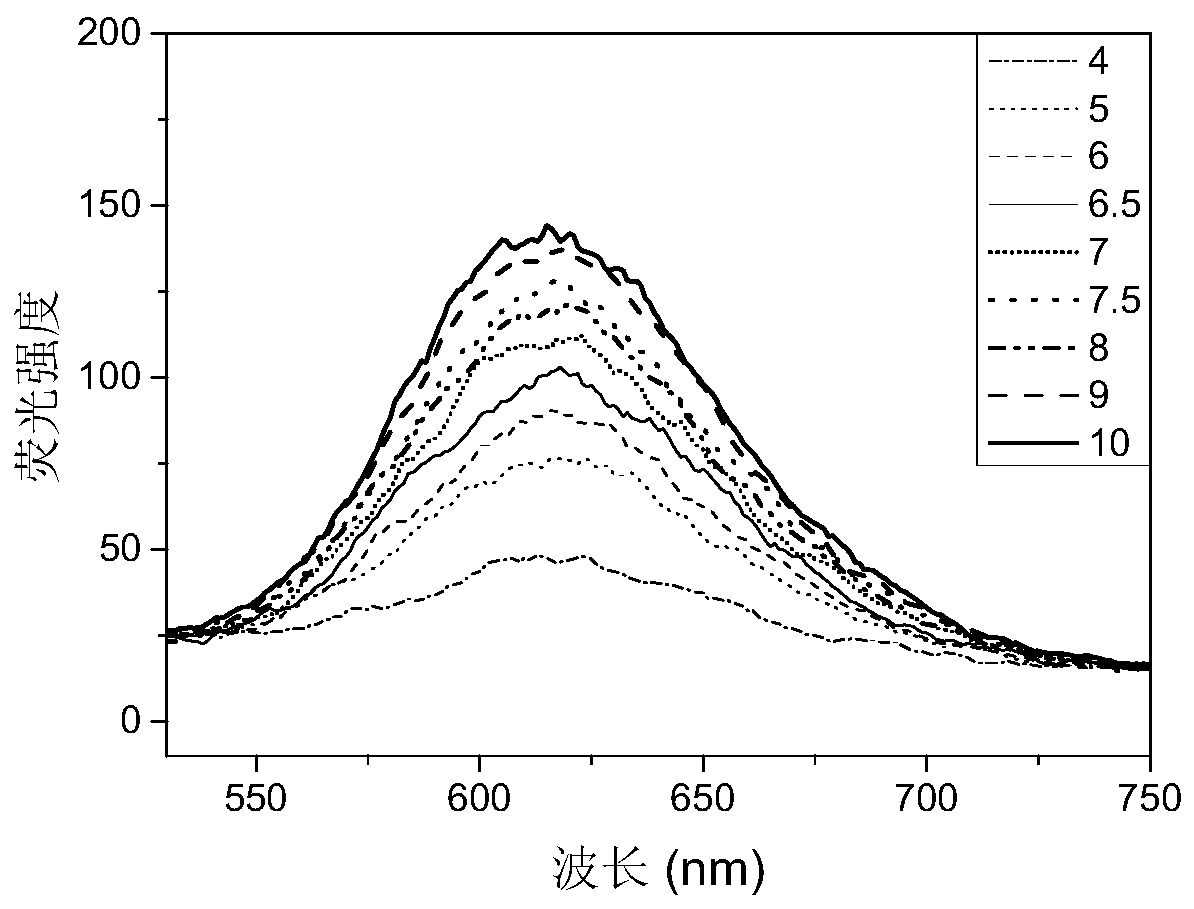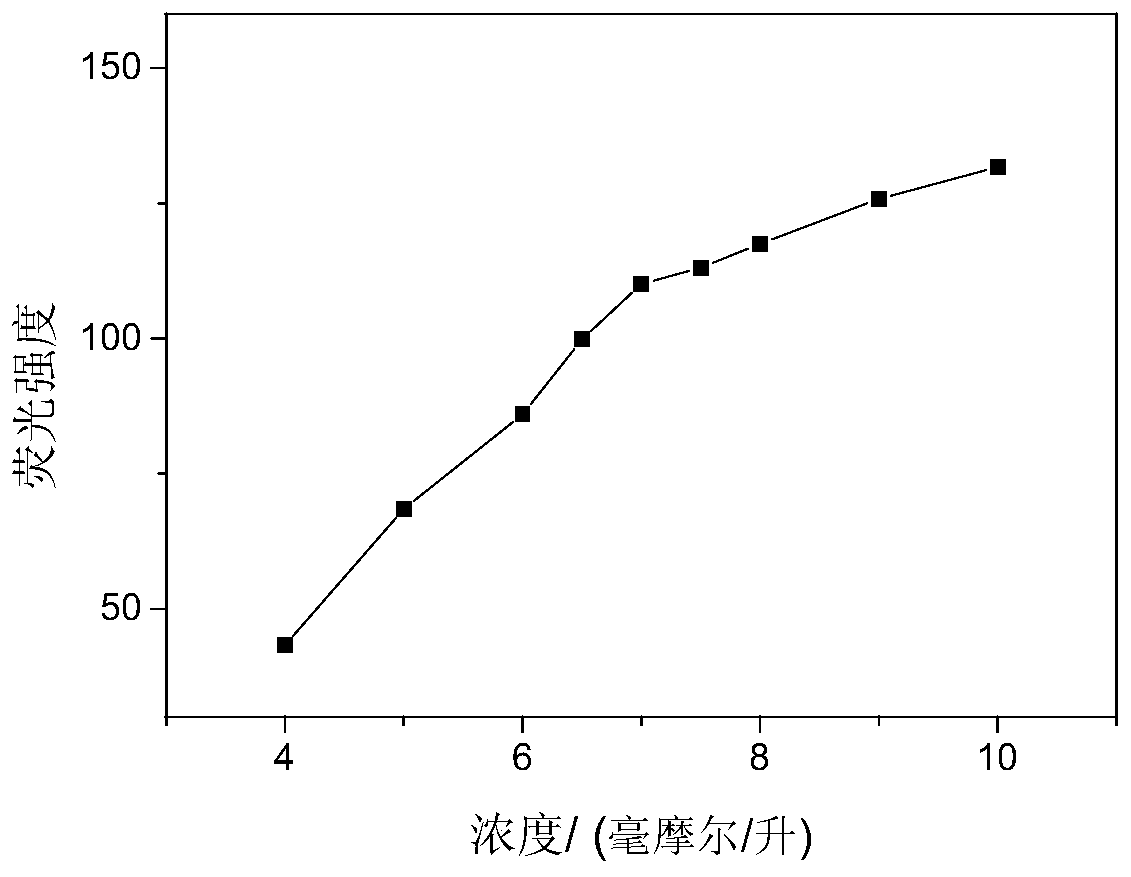Fluorescent probe based on aggregation-induced emission characteristics, method for determining critical micelle concentration by using fluorescent probe and application of fluorescent probe
A technology of aggregation-induced luminescence and critical micelle concentration, which is applied in the direction of luminescent materials, fluorescence/phosphorescence, chemical instruments and methods, etc., can solve the problems of complex operation, unfavorable detection, poor water solubility, etc., and achieve simple operation, simple preparation, and use convenient effect
- Summary
- Abstract
- Description
- Claims
- Application Information
AI Technical Summary
Problems solved by technology
Method used
Image
Examples
Embodiment 1
[0041] (1) Prepare AIE probe I with aqueous solution to a concentration of 2.5*10 -3 mol L -1 stock solution;
[0042] (2) Weigh 288.00 mg of anionic surfactant sodium dodecyl sulfate (SDS) (molecular weight 288) in a 100 mL volumetric flask, add double distilled water until the sample is dissolved, and use double distilled water to constant volume so that the concentration is 10mM SDS stock solution;
[0043] (3) At room temperature, take 4, 5, 6, 6.5, 7, 7.5, 8, 9, and 10 mL of the SDS stock solution prepared in (2) into nine 10 mL volumetric flasks, and add 0.1 mL of ( 1) The prepared AIE probe I stock solution was fixed to volume with double distilled water, and shaken evenly to obtain SDS sample solutions with concentrations of 4, 5, 6, 6.5, 7, 7.5, 8, 9, and 10 mM respectively;
[0044] (4) Measure the fluorescence emission spectrum (λ ex =415nm), the fluorescence intensity at the maximum emission wavelength is plotted against the corresponding SDS concentration, suc...
Embodiment 2
[0047] (1) Prepare AIE probe I with aqueous solution to a concentration of 2.5*10 -3 mol L -1 stock solution;
[0048] (2) Weigh 312.00mg of non-ionic surfactant fatty alcohol polyoxyethylene ether (AEO) (molecular weight 312) into a 100mL volumetric flask, add double distilled water until the sample is dissolved, and use double distilled water to constant volume, so that the concentration 10mM AEO stock solution;
[0049] (3) At room temperature, take 0.25, 0.5, 1, 1.2, 1.4, 1.6, 1.8, 2, 2.5mL of the AEO stock solution prepared in (2) into nine 10mL volumetric flasks, and add 0.1mL of (1) Prepare the AIE probe I stock solution, use double-distilled water to constant volume, shake well, so that AEO samples with concentrations of 0.25, 0.5, 1, 1.2, 1.4, 1.6, 1.8, 2, 2.5 mM are obtained liquid;
[0050] (4) Measure the fluorescence emission spectrum (λ ex =415nm), the fluorescence intensity at the maximum emission wavelength is plotted against the corresponding AEO concentr...
Embodiment 3
[0053] (1) Prepare AIE probe I with aqueous solution to a concentration of 2.5*10 -3 mol L -1 stock solution;
[0054] (2) Weigh 10 g of non-ionic surfactant Pluronic (F127) into a 100 mL volumetric flask, add double distilled water until the sample is dissolved, and use double distilled water for constant volume, so that a F127 stock solution with a concentration of 10 mg / mL is obtained ;
[0055] (3) At room temperature, take 5, 10, 20, 50, 100, 150, 200, 400, and 800 μL of the F127 stock solution prepared in (2) into nine 10mL volumetric flasks, and add 0.1mL of ( 1) For the prepared AIE probe I stock solution, use double-distilled water to make constant volume and shake well to obtain F127 with concentrations of 0.05, 0.1, 0.2, 0.5, 1.0, 1.5, 2.0, 4.0, and 8.0 mg / mL, respectively. sample liquid;
[0056] (4) Measure the fluorescence emission spectrum (λ ex =415nm), the fluorescence intensity at the maximum emission wavelength is plotted against the corresponding F127 ...
PUM
 Login to View More
Login to View More Abstract
Description
Claims
Application Information
 Login to View More
Login to View More - R&D
- Intellectual Property
- Life Sciences
- Materials
- Tech Scout
- Unparalleled Data Quality
- Higher Quality Content
- 60% Fewer Hallucinations
Browse by: Latest US Patents, China's latest patents, Technical Efficacy Thesaurus, Application Domain, Technology Topic, Popular Technical Reports.
© 2025 PatSnap. All rights reserved.Legal|Privacy policy|Modern Slavery Act Transparency Statement|Sitemap|About US| Contact US: help@patsnap.com



